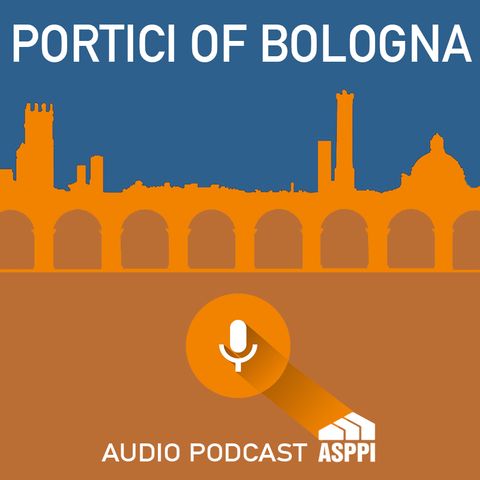Portici of Bologna. Via Galleria (English)

Descarga y escucha en cualquier lugar
Descarga tus episodios favoritos y disfrútalos, ¡dondequiera que estés! Regístrate o inicia sesión ahora para acceder a la escucha sin conexión.
Descripción
Via Galliera began at Porta Galliera and originally ended in front of the Cathedral of St. Peter's, already present in its original plan in the X century AD. The street...
mostra másThe street was the ancient Galeria road which went to the river port town of Galliera directly connected to the Po. With the creation of Via dell’Indipendenza in the second half of the 1800s the street changed and divided into two sections one of which is via Manzoni.
Via Galliera was nicknamed the Grand Canal of Bologna and has always been one of its most elegant and important streets. Until the late 19th century it was the North entrance to the city and the aristocrats considered it very prestigious and a privilege to build their residences commissioned to the most important architects of the time, along this street.
Along today's Via Manzoni are historical buildings with their porticoes such as Renaissance Palazzo Fava, now Palazzo delle Esposizioni, where, in the 1600s, the family of Carracci painters proved their greatness in frescoing the piano nobile of the palazzo. There is also Palazzo Ghisilardi, today seat of the Medieval Art Museum, one of the most beautiful noble palaces of Bologna of the 1400s. Here, from 1923, was one of the first Case del Fascio (Houses of Fascism) with inside it, amongst other amenities, a restaurant where, in 1929 Enzo Ferrari and his associates decided to start the Scuderia Ferrari.
At the crossing with via Galliera is Casa Castelli, of the 1400s and with a portico restored at the beginning of the 1700s. In this building opened the first postal office of Bologna in 1768!
At no. 4, is Palazzo Torfanini, refurbished in the 1700s by Torreggiani who didn't change the original portico of the 1500s. Here, between the 1880s and the 1920s was the prestigious salotto (an Italian word which defines a place for cultural gatherings) of Countess Carmelita Zucchini Solimei, open to the arts, to literature and to politics. Illustrious foreign visitors to Bologna would stop here, like the Prince of Wales and the Infanta of Spain and famous Italians such as the Duke of Aosta, Carducci, D'Annunzio and Eleonora Duse, Fogazzaro, Respighi, they were all welcome!
In the Casa Dalle Tuate, originally with a wooden portico, rebuilt in stone in the 1600s, are two reused capitals almost surely from the Bentivoglio palace destroyed in 1507. The capital on the corner pilaster shows the profile of Giovanni II Bentivoglio, lord of Bologna before the ruling of the popes: a rare portrait which survived the damnation of memory to which the family fell too. Facing the Casa is Palazzo Dal Monte, probable work of architect Peruzzi, with a raised portico of 5 arches supported by stone pilasters with columns with composite style capitals on the side facing the street.
Very original is Palazzo Aldrovandi Montanari, dating to the 1700s and with a Baroque façade designed by Torreggiani. The family, to avoid having a porticoed front, paid a fine as porticoes were compulsory for newly planned buildings.
Facing this building is Palazzo Felicini Fibbia with an elegant brick façade with portico. Here, in 1515 Leonardo da Vinci was a guest together with Giuliano dè Medici, in town for the meeting between pope Leo X and king Francis I, who was so incredibly impressed by the genius of Leonardo, to invite him to France.
Palazzo Bonasoni, of the late 1500s and by architect Antonio Morandi known as Terribilia, presents a raised portico with composite columns and capitals, which are amongst the most remarkable of local workmanship.
We reach Piazzetta della Pioggia where, besides the porticoed church dedicated to the Madonna della Pioggia, are some of the oldest renowned shops of the area, like the Drogheria (grocer's shop), opened at as an apothecary the beginning of the 1600s. After the square begins a maybe less noble Via Galliera but still historically important as we are reminded just before reaching the ancient city gate, by a plaque at no. 65, where, it states, Nicolò Copernicus in 1497 and 1500, made some of his "ingenious celestial observations".
Información
| Autor | ASPPI |
| Organización | ASPPI |
| Página web | - |
| Etiquetas |
Copyright 2024 - Spreaker Inc. an iHeartMedia Company

Comentarios